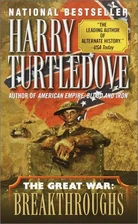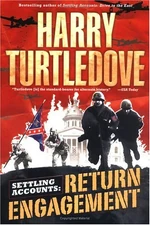| Charles W. La Follette | |
| Fictional Character | |
| Southern Victory POD: September 10, 1862 | |
| Appearance(s): | The Victorious Opposition through In at the Death |
| Nationality: | United States |
| Religion: | Protestantism |
| Date of Birth: | 19th century |
| Occupation: | Lawyer, Politician |
| Parents: | Robert M. La Follette |
| Spouse: | Unnamed Wife |
| Political Party: | Socialist Party |
| Political Office(s): | United States Representative from Wisconsin, Speaker of the House, Vice President of the US, President of the US |
Charles W. "Charlie" La Follette became the 33rd President of the United States after the death of Al Smith during the Second Great War. He had previously served as a U.S. Congressman from Wisconsin, Speaker of the U.S. House, and Vice President under Smith. As President, La Follette oversaw the complete defeat of the Confederate States and the beginning of their subsequent reintegration into the Union. However, La Follette wound up paying for Smith's missteps before the war, and lost his bid for election in 1944.
La Follette was the son of Robert M. La Follette, a respected Socialist Congressman prior to the Great War.[1] Charles La Follette distinguished himself nationally as Speaker of the U.S. House of Representatives beginning in 1935. Al Smith, then Governor of New York, became the Socialist candidate for presidency in 1936. He chose La Follette for his running mate. Even the staunchest of Democrats acknowledged La Follette's formidable intelligence, especially compared with that of President Herbert Hoover's running-mate, William Borah. Smith and La Follette won handily. They were re-elected in 1940, after Smith had successfully concluded the Richmond Agreement with Confederate President Jake Featherston.
However, once the terms of the Richmond Agreement were met, including the return of the states of Kentucky and Houston to the C.S., Featherston began to demand more territorial cessions from the United States and was surprised when Smith refused. After Featherston re-militarized Kentucky in the wake of the Frankfort Incident, Smith slowly mobilized the US military. In 1941, Featherston launched Operation Blackbeard, a surprise attack on the United States, and the beginning of the Second Great War in North America. Smith did his best to rally the country, but in 1942, he was killed when a Confederate bombing raid hit Powel House. A shaken La Follette was immediately sworn in.
Very early on, La Follette decided that the best way for the U.S. to win the war was to allow the military to fight with minimal interference from the executive branch. In 1942, he tried to make peace with Mormon Rebels, but was rebuffed by their leadership, a move heavily criticized by Democrats and Socialists alike in Congress. He would however accept the Mormons' unconditional surrender the following year.
La Follette did not distinguish his administration during the Second Great War until late 1943, when, with General Irving Morrell's army threatening Atlanta, Georgia and General Abner Dowling's Eleventh Army in possession of Camp Determination, Texas, he demanded Confederate President Jake Featherston's surrender before a joint session of Congress. Featherston refused to surrender and fired two massive rockets into Philadelphia to make it clear that the war was far from won.
Upon the revelation of the Freedom Party's efforts to exterminate its black population in 1943, La Follette announced his intention to issue an executive order forbidding discrimination based on race in the recruitment, training, and promotion in the U.S. armed forces on December 15, 1943, effectively allowing blacks into the military (other non-whites, such as Asians and Native Americans were already allowed to serve). He also prepared legislation that would protect all blacks within the jurisdiction of the U.S. In early 1944, La Follette visited captured Richmond, a feat even Theodore Roosevelt couldn't achieve.
The United States triumphed in July 1944, with Featherston's death and the complete occupation of C.S. territory. La Follette ran for election in his own right in 1944 against Thomas Dewey. His running mate was Congressman Jim Curley of Massachusetts. Despite the fact that La Follette had led the country through the Second Great War, Dewey's message that the Democrats would firmly clamp down on the former C.S. and that the Socialists' policies had allowed the C.S. attack in the first place appealed to the American people. The La Follette-Curley ticket was defeated. In fact, La Follette wasn't even able to carry his home state of Wisconsin, which was carried by the Republican Governor of Minnesota. La Follette left office on February 1, 1945.
See Also[]
- Harry Truman, the 33rd President of the United States in OTL, who, having ascended during a global conflict, led the country to victory.
- Cordell Hull, the 33rd President of the United States in Worldwar, who also ascends during a global conflict and leads the country to something like victory.
- John Nance Garner, the 33rd President of the United States in Joe Steele, (both in the novel and the story), who also ascends upon the death of his predecessor, only to be removed from office.
- Henry Wallace, the Vice President from 1941 to 1945 in OTL.
References[]
- ↑ The La Follette family history is not referenced in the text, but Harry Turtledove confirmed in a 2018 Tweet that Charles W. is a fictional analog of Robert M. La Follette Jr. (1895–1953).
| Titles and Succession | |||||||||||||||||||||
|---|---|---|---|---|---|---|---|---|---|---|---|---|---|---|---|---|---|---|---|---|---|
| |||||||||||||||||||||












